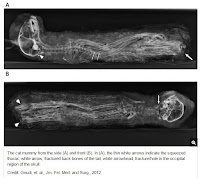THE AGE OF AKHENATEN
The pharaoh Akhenaten, King Tut’s controversial father, departed from centuries of tradition after taking power in 1353 B.C. Changes during his 17-year reign included new styles of art and architecture and mass celebrations of the sun god Aten that pushed the old gods aside.
A very ancient Egyptian Easter: Sham El-Nessim
Sham El-Nessim has been celebrated by Egyptians since ancient times, regardless of religious background or social status. Ahram Online republishes this short history of the holiday.
Monday 21 April marks Sham El-Nessim, a festival that takes place in the same breath as Easter, falling on the day after Easter Sunday each year.
Another article on Sham El-Nessim: Salted Fish Carries Taste of Spring All Way from Pharaonic Egypt
"Mighty in Waking and Great in Sleeping: the History of Beds in Ancient Egypt"
At the beginning of April Manon Y. Schutz came to talk to us at the Essex Egyptology Group about beds in Ancient Egypt. She's a D.Phil student at Oxford University, and beds in an Ancient Egyptian funerary context are the subject of her thesis. She has chosen to look at the funerary context because most of the evidence of beds that survives is from tombs. Her talk was divided into two parts - first an introduction to the topic of beds in Ancient Egypt, and then an overview of beds throughout Ancient Egyptian history.
Egyptian archaeologists unearth tomb of 18th Dynasty magistrate in west Luxor
An Egyptian archaeological mission in Luxor has announced the discovery of a major tomb in the city's west bank area dating back to the 18th Dynasty and containing priceless artefacts.
Mostafa Waziry, Director General of Luxor Antiquities, told reporters on Tuesday that the tomb, which was unearthed in the Zeraa Abu El-Nagaa necropolis, most likely belonged to the city's magistrate Ou Sarhat.
Other articles on this find:
- Six mummies discovered in ancient tomb near Egypt’s Luxor Several mummies unearthed in ancient tomb near Egypt’s Luxor
- Egyptian archaeologists discover EIGHT MUMMIES in 3,500-year-old tomb near ancient city of Luxor (Great Photos)
- In photos: Pharaonic cemetery with dozens of coffins, gold-colored masks discovered in Luxor
- Exclusive: Big discovery of a new tomb in Luxor
- Exclusive footage: Amazing new finds by an Egyptian team in Luxor
Newly-discovered 3,000-year-old statue of pharaoh to be inaugurated
The eight-meter statue of an ancient pharaoh discovered in a Cairo slum in March has been restored and will be inaugurated on Tuesday at Luxor Temple by Antiquities Minister Khaled al-Anany, Luxor governor Mohamed Badr and a number of foreign ambassadors to mark UNESCO's International Day for Monuments.
The eight-meter statue of an ancient pharaoh discovered in a Cairo slum in March has been restored and will be inaugurated on Tuesday at Luxor Temple by Antiquities Minister Khaled al-Anany, Luxor governor Mohamed Badr and a number of foreign ambassadors to mark UNESCO's International Day for Monuments.










































